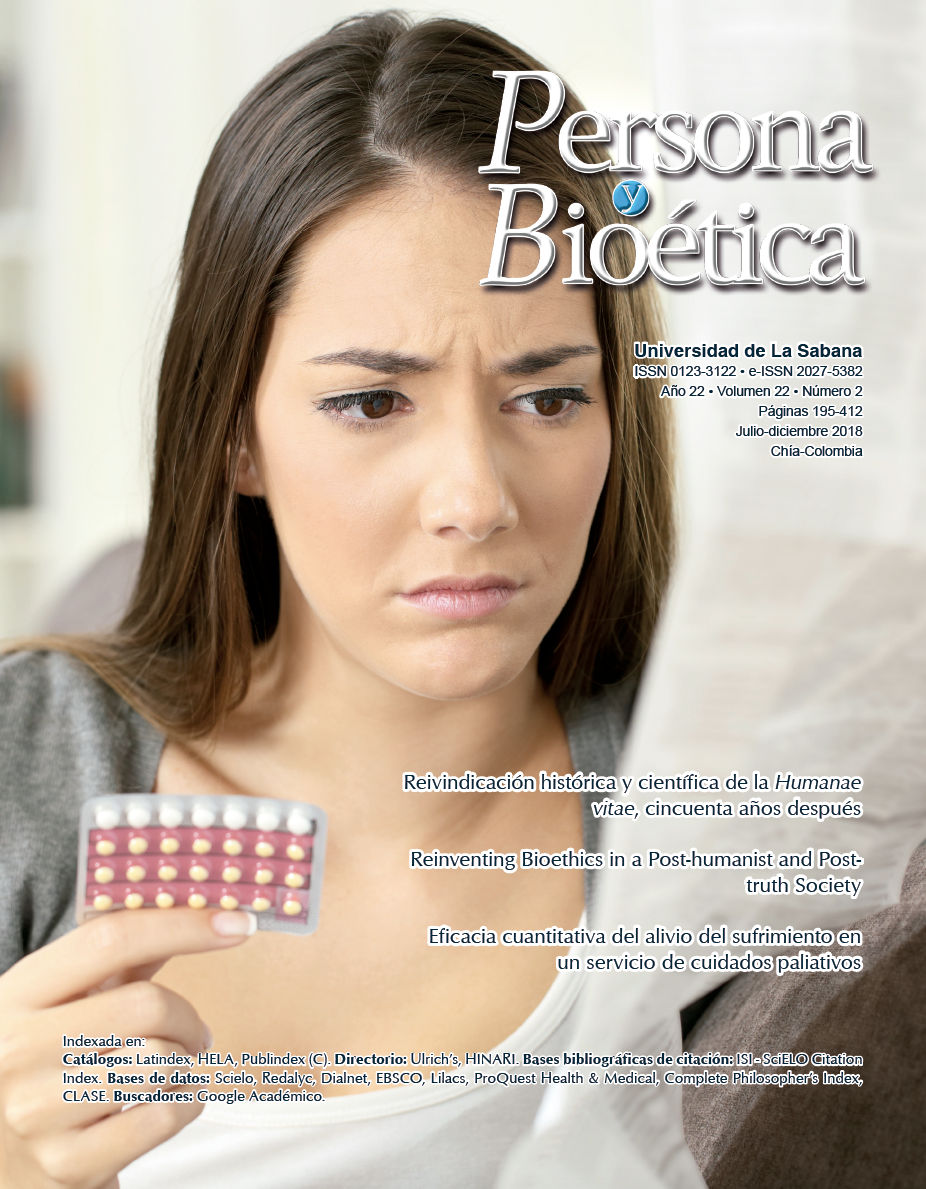Humanae vitae, ideología de género y futuro biotecnológico
DOI:
https://doi.org/10.5294/pebi.2018.22.2.11Palabras clave:
Ideología de género, identidad de género, LGTB, LGTBI, Humanae Vitae, antropologia de la sexualidad, biotecnologia, biomarcador, ventana fértil, reconocimiento de la fertilidad, ovulaciónResumen
Humanae Vitae, Gender Ideology and Biotechnological Future
Humanae vitae, ideologia de gênero e futuro biotecnológico
Este artículo corto tiene como finalidad hacer un comentario breve alusivo a la influencia de la Humanae vitae, cincuenta años después de haber sido publicada. En este contexto se comentan algunos aspectos alusivos a la influencia positiva que confiere esta encíclica al entorno afectivo de la sexualidad, tanto en la edad adulta como en edades temprana de la juventud, ante la influencia de la ideología LGTBI. La visión antropológica de la sexualidad confiere un entorno de respeto por la dignidad de la persona, ante las desviaciones que pueden llegar a presentarse debidas a la influencia de la ideología de género. Finalmente, se citan algunos artículos científicos de índole internacional, que ilustran positivamente la posibilidad de compatibilizar la ciencia con el carácter unitivo y procreativo de la Humanae vitae, en un entorno globalizado.
Para citar este artículo / To reference this article / Para citar este artigo
Murcia-Lora JM. Humanae vitae, ideología de género y futuro biotecnológico. pers. bioét. 2018; 22(2): 358-366. DOI: 10.5294/pebi.2018.22.2.11
Descargas
Citas
Sedgh G et al. Abortion incidence between 1990 and 2014: global, regional, and subregional levels and trends. Lancet. 2016;388(10041):258-67. DOI: 10.1016/S0140-6736(16)30380-4
Elnashar AM, Aboul-Enein GI. Endometrial receptivity. Mid East Fertil Soc J. 2004;9(1):10-24. Disponible en: http://www.bioline.org.br/pdf?mf04003
Noci I, Marchionni M, Fambrini M, Cioni R, Scarselli G. Fertilisation and implantation failure in an oral contraceptive user. Eur J Obstet Gynecol Reprod Biol. 2002;104(1):73-5. DOI: 10.1016/S0301-2115(02)00054-4
Wilks J. El impacto de la píldora en los factores de la implantación. Nuevos descubrimientos de la investigación científica. Ethics Med. 2000;16(1):15-22. Disponible en: http://contracepcion.info/ETHMEDS.PDF
Ganatra B, Gerdts C, Rossier C, et al. Global, regional, and subregional classification of abortions by safety, 2010-14: Estimates from a Bayesian hierarchical model. Lancet. 2017; 90: 2372-81. DOI: 10.1016/S0140-6736(17)31794-4.
Govaerts I, Devreker F, Delbaere A, Revelard P, Englert Y. Short-term medical complications of 1500 oocyte retrievals for in vitro fertilization and embryo transfer. Eur J Obstet Gynecol Reprod Biol. 1998;77:239-43. DOI: 10.1016/S0301-2115(97)00263-7
Brinsden PR, Wada I, Tan SL, Balen A, Jacobs HS. Diagnosis, prevention and management of ovarian hyperstimulation syndrome. Br J Obstet Gynaecol. 1995;102:767-72. Disponible en: https://www.ncbi.nlm.nih.gov/pubmed/7547731
Schieve LA, Meikle SF, Ferre C, Peterson HB, Jeng G, Wilcox LS. Low and very low birth weight in infants conceived with use of assisted reproductive technology. N Engl J Med. 2002;346:731-7. DOI: 10.1056/NEJMoa010806
Hansen M, Kurinczuk JJ, Bower C, Webb S. The risk of major birth defects after intracytoplasmic sperm injection and in vitro fertilization. N Engl J Med. 2002;346:725-30. DOI: 10.1056/NEJMoa010035
Stromberg B, Dahlquist G, Ericson A, Finnstrom O, Koster M, Stjernqvist K. Neurological sequelae in children born after in-vitro fertilisation: A population-based study. Lancet. 2002;359:461-5. DOI: 10.1016/S0140-6736(02)07674-2
The ESHRE Capri Workshop Group. Multiple gestation pregnancy. Hum Reprod 2000;15:1856-64. Disponible en: https://www.ncbi.nlm.nih.gov/pubmed/10920117
Schieve LA, Peterson HB, Meikle SF, et al. Live- birth rates and multiple-birth risk using in vitro fertilization. JAMA. 1999;282:1832-8. DOI: 10.1001/jama.282.19.1832
Loredo-Abdalá A, Vargas-Campuzano E, Casas-Muñoz A, González-Corona J, Gutiérrez-Leyva CJ. Adolescent pregnancy: Its causes and repercussions in the dyad. Rev Med Inst Mex Seguro Soc. 2017;55(2):223-9. Disponible en: http://www.medigraphic.com/cgi-bin/new/resumenI.cgi?IDARTICULO=71939
Shah I, Ahman E. Unsafe abortion: global and regional incidence, trends, consequences, and challenges. J Obstetr Gynaecol Can. 2009;31(12):1149-58. Disponible en: https://www.clinicalkey.es/service/content/pdf/watermarked/1-s2.0-S1701216316343766.pdf?locale=es_ES
Bruce MC. Embriología humana y biología del desarrollo. 5 ed. Elsevier: Barcelona; 2014.
Speroff L, Fritz MA. Regulación del ciclo menstrual. Endocrinología ginecológica clínica y esterilidad. 7 ed. Lippincott Williams & Wlilkins; 2006.
Gotzon M. Saber amar con el cuerpo. 7 ed. Madrid: Palabra; 2005.
Pablo VI. Carta encíclica Humanae vitae. Ciudad del Vaticano: Editrice Vaticana; 1968.
Evangelio según San Marcos 10, 8-12.
Alexander H, Kaczmarczyk M, Pretzsch G, Kersken GT, Puschmann D, Schiwek E, et al. The 2nd Biomarker Meeting in Personalized Reproductive Medicine. Continuous Measurements of Core Body Temperature as Biomarker for Ovulation Diagnosis. 085 Poster Valencia-Web. España; 2014.
Su HW, Yi YC, Wei TY, Chang TC, Cheng CM. Detection of ovulation, a review of currently available methods. AIChE Bioeng Trans Med. 2017;2:238-46. DOI: 10.1002/btm2.10058
WO2018178753 – 2018 10 04. Biosensor for Biophysical Measurement of Cervical Secretion.
Keulers MJ, Hamilton CJ, Franx A, Evers JL, Bots RS. The length of the fertile window is associated with the chance of spontaneously conceiving an ongoing pregnancy in subfertile couples. Hum Reprod. 2007;22(6):1652-56. DOI: 10.1093/humrep/dem051
Simon C, Sakkas D, Gardner DK, Critchley HO. Biomarkers in reproductive medicine: The quest for new answers. Hum Reprod. 2015;21(6):6957. DOI: 10.1093/humupd/dmv043
Thijssen A, Meier A, Panis K, Ombelet W. Fertility awareness-based methods’ and subfertility: A systematic review. Facts Views Vis Obgyn. 2014,6(3):113-23. Disponible en: https://www.ncbi.nlm.nih.gov/pmc/articles/PMC4216977/
Sharma N. Challenges in the field of biomedical engineering research. Op Acc J Bio Eng Bio Sci. 2018;2(1):OAJBEB.MS.ID.000128. DOI: 10.32474/OAJBEB.2018.02.000128
Hilgers TW. The Medical & Surgical Practice of NaProTechnology. Nebraska: Pope Paul VI Institute Press.
Scarpa et al. Cervical mucus secretions on the day of intercourse: An accurate marker of highly fertile days. Europ J Obstet Gyneco Reprod Biol. 2006;125:72-8. DOI: 10.1016/j.ejogrb.2005.07.024
Murcia LJM, Mejía QJE, Falces de A. Fertility awareness and biotechnological application by innovation networks. Int Gyn & Women’s Health. 2018;2(3). IGWHC.MS.ID.000144. DOI: 10.32474/IGWHC.2018.02.000136
Murcia Lora JM. Biophysical biomarkers of the fertile window in sub-fertile women: Individual approach. Int Gyn & Women’s Health. 2018;2(4). IGWHC.MS.ID.000144. DOI: 10.32474/IGWHC.2018.02.000144
Murcia Lora JM. Clinical Biomarkers and Biotechnology in Fertile Window. Int Gyn & Women’s Health. 2018;2(2). IGWHC.MS.ID.000135 DOI: 10.32474/IGWHC.2018.02.000135









